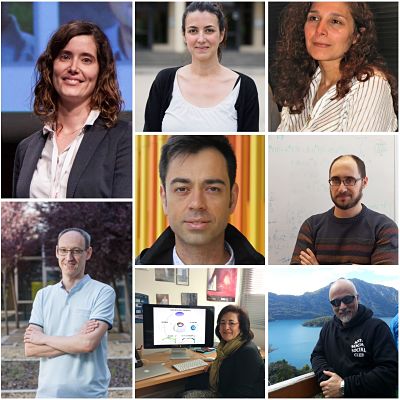Quantum information: A molecule capable of implementing a quantum error-correcting code is developed
The integration of algorithms at the molecular scale promises to help increase the power of future quantum computers
The prestigious journal Chemical Science has highlighted this scientific finding as “Pick of the Week” and dedicated the cover of its latest issue to it
The work has been carried out by researchers from INMA (joint centre CSIC-UNIZAR), in collaboration with the University of Barcelona and the University of Parma (Italy) in the framework of a European project, led from Aragon, which aims to build a quantum processor based on magnetic molecules.
(Zaragoza, 9 September 2020). An international collaboration, involving researchers from the Institute of Nanoscience and Materials of Aragon (INMA, a joint centre of the CSIC and the University of Zaragoza) and the Universities of Barcelona and Parma (Italy), has managed to develop a magnetic molecule that is capable of carrying out a simple, but crucial, quantum algorithm. It is a code that protects the quantum information stored in each molecule, a “qubit”, from external noise. The work has just been published in the prestigious journal Chemical Science, which has selected it as “Pick of the Week” and dedicated the cover of its latest issue to it.
Making quantum computing a reality faces major technological challenges. One of the most important is the extreme fragility of quantum states (wave functions) in the face of noise. So-called error protection codes offer a solution to this problem at the cost of multiplying the number of qubits encoding each unit of information and thus the fragile interconnections between them. For this reason, creating quantum processors capable of correcting errors without requiring extremely complex architectures has become one of the priority objectives. The work published today in the journal Chemical Science shows that it is possible to encapsulate the simplest algorithm of this type in a single molecule.
The experiments carried out at INMA studied in detail the spin states of molecules, synthesised by researchers from the Department of Inorganic Chemistry at the University of Barcelona, which host three rare earth atoms (two Erbium atoms and one Cerium atom). The results show that each of them encodes a different qubit, weakly coupled to its neighbours, and allow us to characterise both its response to microwave pulses and its sensitivity to noise. Using this information, researchers from the physics department of the University of Parma successfully simulated the application of an error-correction protocol in which the spin of one of the atoms encodes the information, while the other two allow to detect the appearance of errors and correct them.
This work is part of a project led by the INMA, which aims to build a prototype of a quantum processor based on artificial magnetic molecules integrated into superconducting circuits that control, read and communicate with each other each of these basic units. This initiative is supported by two international collaboration projects, the SUMO project funded in 2018 by the QUANTERA programme, a part of the European Flagship in Quantum Technologies, and the FATMOLS project of the European FET-OPEN call that started in March this year. With overall funding of more than ¤3 million, FATMOLS involves 9 prestigious academic institutions from 5 countries, as well as two major industrial partners: Keysight, the world leader in microwave electronics, and the computer giant IBM.
The possibility of carrying out small algorithms on a molecular scale, as shown in this work, is one of the most important advantages of this proposal, since it reduces the number of communications between different points of the quantum circuit and, therefore, its complexity. It also greatly increases the ability to integrate more qubits on a chip, which translates into higher processor power. The combination of both features gives a competitive advantage over schemes based on superconducting qubits when dealing with quantum simulations and calculations with real application and added value.
More information: Fernando Luis Vitalla, 876 55 33 42, fluis@unizar.es.
Reference to the original article:
A heterometallic [LnLn’Ln] lanthanide complex as a qubit with embedded quantum error correction, Emilio Macaluso, Marcos Rubín, David Aguilà, Alessandro Chiesa, Leoní Barrios, Jesús I. Martínez, Pablo J. Alonso, Olivier Roubeau, Fernando Luis, Guillem Aromí and Stefano Carretta
Chemical Science (9 September 2020):
https://pubs.rsc.org/en/content/articlelanding/2020/sc/d0sc03107k
Artistic image of the realisation of a quantum algorithm in the new magnetic molecule. In pink, the Cerium atom whose spin encodes the quantum information. In green, Erbium atoms that “alert” to the existence of errors and allow information to be retrieved.










